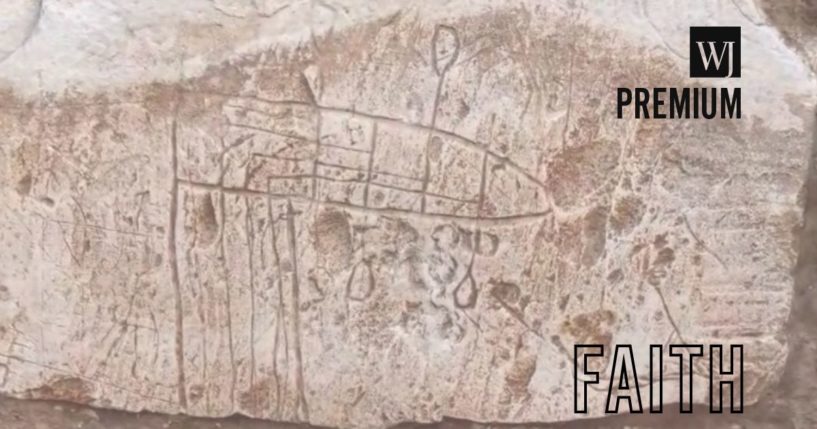
'Surprising': 1,500-Year-Old Church with 'Intriguing' Christian Wall Art Discovered by Israeli Archaeologists
The ruins of an ancient church in Israel’s Negev Desert have yielded clues to the lives of long-ago Christians who set sail on the ocean to make pilgrimages to the Holy Land.
The Israel Antiquities Authority announced the discovery of newly excavated archaeological engravings in a Facebook post promoting an upcoming conference at the Rahat Municipal Cultural Hall. The Byzantine-era art reflects the ships on which Christians sailed during their journeys to Israel.
The carvings, within the context of the great travel risks (especially maritime travel) for pilgrimages, suggest grand Christian enthusiasm in reaching the port of Gaza, as reflected on the 1,500-year-old walls of the unearthed Rahat church in which they were found. That’s a time frame of just 500 years after Christ.
Excavations have been taking place in the area for many years, according to the Israel Antiquities Authority. This particular wall art, however, seems to display greetings left by the pilgrims for others to enjoy — possibly a welcome mat for other pilgrims to follow.
According to The Jerusalem Post, “The excavated site tells the story of settlement in the northern Negev at the end of the Byzantine period and in the beginning of the Early Islamic period. Pilgrims visited the church and left their personal mark in the form of ship drawings on its walls. The ship is indeed an old Christian symbol, but in this case, apparently, it is a true graphical depiction of real ships in which the pilgrims traveled to the Holy Land,” representatives of the IAA said.
According to a YouTube video addressing the discovery, the wall art was a complete surprise, as was the very large church it adorned. Excavation director and archaeologist Oren Shmueli, who spoke in the video, revealed that the excavation was funded by the Authority for Development and Settlement of the Bedouin in the Negev, which is preparing for the resettling of additional Bedouin residents in the area.
“And on one of the hot summer days, one of the area managers called us over and showed us an engraving.”
The more the team worked and looked, the more engravings they would uncover of all kinds of ships. Let us not forget that the discovery was made in the middle of the desert.
Within the video, one archaeologist described some of the mysteries hinted at by the artwork. “We are in the south, and we are in the middle of a desert. When do we see ships in the desert?”
According to the IAA, “The site of the ancient church with the ship drawings is indeed adjacent to an ancient Roman road that led from the Mediterranean coastal port of Gaza to Beer Sheva, the Negev’s main city.” This leads them to consider that this church might have been the first stop made by the pilgrims following the exiting of their ships at the port.
It is merely a half-a-day’s walk from the port to the church. It is a reasonable assumption.
איך הגיעו עיטורי ספינות שיט ללב המדבר לפני כ-1500 שנה, ומה בדיוק הם עשו שם? ולמה הם נחרתו דווקא על קירות הכנסיה הקדומה שגילו הארכיאולוגים שלנו ברהט שבצפון הנגב? התגלית החדשה הזו-ועוד רבות אחרות, תוצג לציבור ב”כנס רהט הראשון” ב-4.6, וכולכם מוזמנים להגיע!>> pic.twitter.com/dbbt3zSKmL
— רשות העתיקות – Israel Antiquities Authority (@AntiquitiesIL) May 23, 2024
According to Professor Deborah Cvikel of Haifa University’s department of maritime civilizations, “One of the ships drawn on the church walls is depicted as a line drawing, but one can see that its bow is slightly pointed and that there are oars on both sides of the vessel. This may be an aerial depiction of the ship, though it seems the artist was attempting a three-dimensional drawing. It may be that the lines below it depict the path beaten by the oars through the water. Ships or crosses left by visiting Christian pilgrims as witness to their visit are found also in Jerusalem’s Holy Sepulchre church.“
A two-masted ship also adorns the walls of the church. The drawing was placed upside down by the person placing the stone during construction, seemingly indicating a lack of familiarity or care by the worker.
The enthusiasm of the discovery team seems to reflect that of the pilgrims who arrived at the port themselves.
Israel Antiquities Authority Director Eli Escusido said, “This surprising and intriguing find of ship drawings in a Northern Negev Byzantine-period church opens a window for us to the world of Christian pilgrims visiting the Holy Land 1,500 years ago, and provides first-hand evidence about the ships they traveled in and the maritime world of that time.”
Not only is this a monumental find, but it sheds light on early Christian worship as a “true graphical depiction of real ships in which Christian pilgrims traveled to the Holy Land” 1,500 years ago.
That certainly is quite the discovery, especially given the Israel-Hamas war taking place at present.
Truth and Accuracy
We are committed to truth and accuracy in all of our journalism. Read our editorial standards.
Advertise with The Western Journal and reach millions of highly engaged readers, while supporting our work. Advertise Today.










